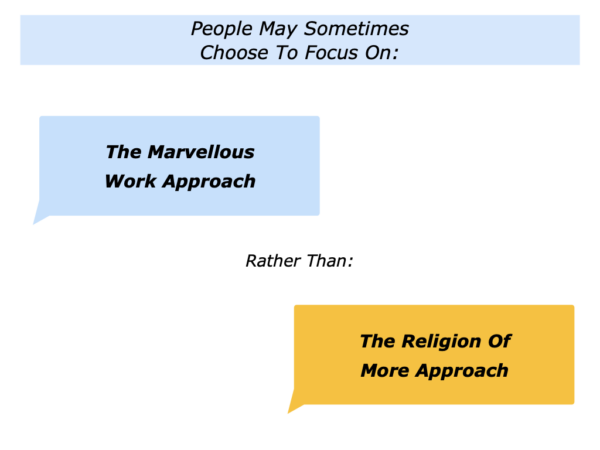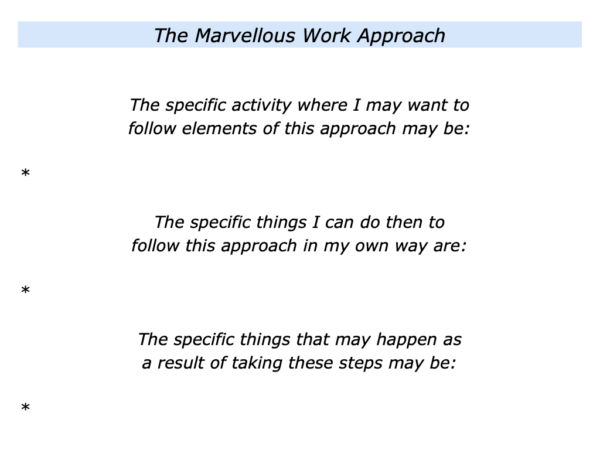
There are many ways to work. Some people reach a point where they make a decision regarding their chosen way forward. Some may choose to follow the marvellous work approach rather than the ever-expanding religion of more approach.
Such people often build on what they do best. They go deeper, develop and aim do even better work. They then do their best to achieve their picture of success.
Some people try to combine the best of both worlds. They aim to continue to do marvellous work and also expand. But this route can have both pluses and minuses. Let’s explore these themes.
The Marvellous Work Approach
And The Religion Of More Approach
Some individuals, teams and companies focus on doing what they do best. They continue to do the maintenance – the things that must be done – and then add the marvellous work.
Some may be tempted to expand. They do lots of due diligence before taking this step, however, and make sure they can set things up to succeed. Let’s look at two different examples.
Company A
Many years ago I did mentoring work with a pacesetting search company. They had a superb leadership team and, eventually, around thirty-five employees.
The company had a certain approach to its work. These included the following Dos and Don’ts.
Dos
Do focus on to what we do best … Do focus on the kinds of customers with whom we work best … Do provide both high tech and high touch – both technology that works and the personal touch.
Do build a culture were motivated people can do great work … Do put the right people in the right places … Do keep people informed about our strategy and picture of success.
Do employ people who want to follow the company’s principles … Do keep the company below forty people in order to maintain the culture … Do focus on the UK and one big country in Europe.
Don’ts
Don’t stray away from our strengths … Don’t try to be all things to all people … Don’t spend time trying to win customers who may be institutionalised … Don’t try to expand into the USA.
Company A aimed to follow these Dos. They sometimes added to their portfolio but refused to do things that took them beyond their core strengths.
They continued to deliver superb work to their customers and build a fine reputation in the market. Five years after starting the company was acquired for more than £50 million.
The company also created a legacy. Many of its employees went on found other companies or have satisfying careers. They then followed many of the Dos regarding performing marvellous work.
Company B
Company B also did good work during the early days of the switch to digital marketing. It had a charismatic leader who created a leadership group full of creative people.
The company was based in the UK and got off to a great start. The leader and its creative people built a fine reputation as thought leaders in their field. They got lots of business which led to them employing many people.
Company B then faced a challenge. It scored highly on innovation, such as providing lots of creative ideas. But much lower on implementation – translating the ideas into action – and delivering the desired impact.
The company aimed to solve this by hiring many people who were good at implementation. They made a mistake, however, by hiring these from big companies rather than entrepreneurial businesses.
The company continued to expand and soon had more than sixty employees. But they found that this produced several problems. These included the following.
The sales teams sometimes failed to make clear contracts with the customers – or over-promised – about the outcomes to be delivered and this created problems for the implementors.
The implementors they had hired spent much of their time designing processes rather than focusing on helping the customers to achieve success.
The company did not have a good recruitment and induction process and found that hiring more people created more problems. This sometimes led to the leadership team resorting to micro management.
Company B kept winning business but at the same time began losing clients who were not satisfied with its customer service. This created a negative cycle.
The founder received an offer to sell the business for £20 million. They refused, however, and decided to keep expanding in order to sell for a higher figure.
The expansion included opening offices in New York and Singapore. The company wanted to develop in the American and APAC markets and, in this way, increase the value of its business.
The company’s strength continued to be innovation. One way it could boost its income was by helping customers to implement the ideas and deliver the desired impact. But this was not its strength.
The reckoning came suddenly. A meeting with the company’s financial backers led to making drastic cuts. The UK operation was reduced from sixty to forty people. The New York and Singapore offices were also closed.
Company B continued to operate in the UK but shifted its approach. It continued to play to its strengths – innovation – but focused on coaching its customers to implement the strategies in-house.
The leader eventually accepted an offer for the company. This was around half the sum they had previously rejected. They wanted to move on to other things, however, rather than stay to run the business.
Since then the leader and several of the leadership team have started another company. It remains to be seen what lessons they have learned from their first exciting venture.
The Marvellous Work And
More Approach Can Be Possible
Sometimes it is possible for people to do marvellous work and follow some elements of the more approach. But this calls for following certain guidelines.
During the past fifty years I have seen individuals, teams and companies follow this approach successfully. When doing so, however, they have sometimes pursued the following principles.
They have continued to build on their strengths and do superb work that has delivered success. This has provided them with the income to, when appropriate, explore other possibilities to add to their portfolio.
They have continued to build on their strengths when pursuing these possibilities but have expressed these strengths in ways that can deliver success in a changing world.
They have applied their strengths to focusing on running prototypes with certain kinds of customers, setting specific goals, finding solutions to challenges and delivering success.
People who take this approach build on their strengths but also on the customer’s needs. They find that tackling real issues adds to their repertoire and also helps the customer to achieve success.
They do their due diligence before taking this approach, however, and set things up to succeed. They increase the chances of success and minimise the risk.
Companies that take this approach continue to build on their strengths and express these in ways that deliver success in an evolving world. They may then choose to add more of the new offerings to their main portfolio.
Some maintain their core offering and start separate businesses that provide the new offerings. They do this in a sustainable way, however, and help the various businesses to achieve success.
Let’s return to your own work. Imagine that you want to focus on a specific activity and follow the marvellous work approach. How can you follow this in your own way?
If wish, try tackling the exercise on this theme. This invites you to complete the following sentences.



Leave a Reply